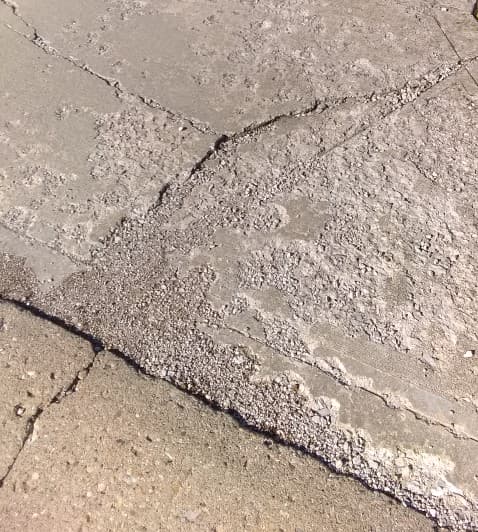
Originally posted 4/30/20, updated 12/14/22
It can be human nature to procrastinate. We’re all probably guilty of it, whether it’s hitting the snooze button in the morning or running the dryer to “fluff” the shirt we didn’t iron. Most of the time, these actions don’t have a major impact on our day. (Assuming you only hit that snooze button once, and made it to work on time.)
But putting off home repairs can have significant consequences to the health of your home, your family and to your budget. Acculevel has been waterproofing homes and repairing foundations since 1996. As a family-owned company, we are in this business to help people; we’ve seen firsthand what happens when homeowners procrastinate about major repairs
Since we specialize in basements, crawl spaces, and foundations, we can’t speak to the cost of all delays. But we can tell you what will happen in our area of expertise if you don’t act promptly. We’ll review the types of repairs that have the most significant cost delays, from best-case to worst.
Helical piers are the best solution for repairing a settling foundation. For details about the repair method and cost, we recommend reading the article linked above.
For this example, let’s say that when you get a quote for installing piers, your foundation has settled approximately one inch. You need two piers installed by machine, and your quote is for $4400.
You decide to wait until you’re putting the house on the market; it doesn’t seem that bad to you. By that time, you learn that the settling is much worse. The doors that were originally just sticking now won’t close (or open), the windows that wouldn’t open have started to splinter, drywall cracks are more pronounced, and your floor is sloping. When your home is reevaluated, your foundation has settled by inches.
Barring an increase in labor or materials, pier installation may not cost you much more than the original quote of $4400. The difference is the amount of adjustment possible, meaning how much we can raise your foundation towards its original position. As we explain in our cost article, the goal of helical piers is to stabilize your foundation- the amount we can lift it can be limited.
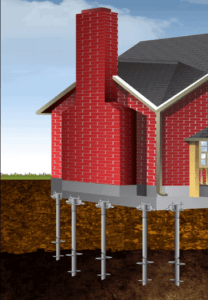 This is an illustration of pier installation.
This is an illustration of pier installation.
This means that your foundation may be stable and secure- but it will still have settled. Raising a foundation several inches may not be possible; the amount of strain this will put on your home’s structure will be significant.
Those issues that have developed (and were flagged on your home inspection report) will need to be repaired. You’ll need to rework doors and windows, replace broken windows, level the floors, and repair or replace drywall. How expensive this is depends on the significance of the damage that has occurred, how much can be lifted during the lifting process, and what you can negotiate with your buyer.
Slabjacking is the best method for lifting sunken concrete slab, whether it’s a patio, pool surround, or driveway. If you’re not familiar with the technique, we have an article that defines it and includes a demonstration video.
If you postpone slabjacking repairs, the cost of your repair will probably increase. Depending on the circumstances, the repair method may even have to change.
Hypothetically, let’s say you have a driveway that is sinking to one side. There’s currently a one inch gap between the slab and your garage floor. It’s annoying, and you trip over it about once a week. It occurs to you that if YOU trip over it, someone else can. That leaves you vulnerable to injury costs and liability issues, which no one likes. So you do the smart thing and request an estimate. You learn that lifting it back to its original position will cost $2415.
You decide you can live with a tripping hazard for a while longer (legal risks and all), and procrastinate for another year or two.
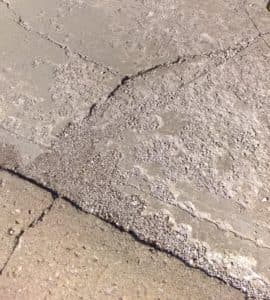 This picture was taken by Acculevel project advisor on a routine free estimate appointment.
This picture was taken by Acculevel project advisor on a routine free estimate appointment.
For option 2? This can’t be slabjacked. It’s in too many pieces, and will not lift evenly. This will have to be torn out and re-poured, which will cost you closer to $5500 to do.
For this one, you have anecdotal evidence from our Sales Director, Nolan Beery. In 2015, he went to a customer’s home. They had water in their crawl space, and he offered them two options: $4500 for a water drainage or $15,000 for complete encapsulation. Encapsulation would have turned the crawl space into a dry space suitable for storage. The customer said he’d think about it, but didn’t act on either estimate.
Two years later, the same customer called, concerned about his sloping floor. The water in the crawl space had done extensive damage. The main beam of the house was rotten, broken, and laying on the ground. All of the joists were rotting and loose in their hangers, and the sill plate was damaged.
The quote this time was for $24,000. Those two years cost almost $20,000.
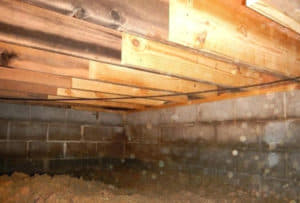 This picture was taken by an Acculevel crew member after repairs were made.
This picture was taken by an Acculevel crew member after repairs were made.
All of the joists in this image were sistered, and the sill plate was replaced.
At this point in my career at Acculevel, any customer that doesn’t promptly repair a bowing wall is a dagger to my heart. In every foundation blog I write, I emphasize that this is NOT something to delay. I even titled one of my blogs, “It is Urgent That You Fix a Bowed or Bulging Basement Wall, and Here’s Why.”
But for the sake of this article, let’s just say: last summer you went downstairs to change the furnace filter. While you were standing there, you noticed something wrong with the nearest wall. It looked just a wee bit nearer to you than it should. It has developed a long horizontal crack and is bowing slightly inward.
You get an estimate, and you learn that you need carbon fiber straps. The wall is 20 feet long; straps should be placed every 4 feet. That’s four straps, and at approximately $660 each, you’re looking at $2640.
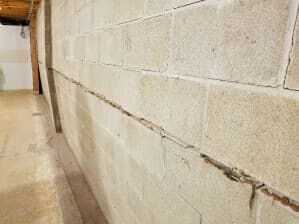 This picture was taken by an Acculevel project advisor during a routine free estimate appointment.
This picture was taken by an Acculevel project advisor during a routine free estimate appointment.
You decide to wait, because you want to break my heart. No, seriously- let’s say you were waiting until you got your tax return, or decided to pay off a few other bills first. One thing becomes another, then another, and one day you go downstairs and that wall crack has become a gap. The wall is now bowing several inches.
Now you need wall anchors that cost $3660 and that requires excavation 10 feet into your yard. It’s a bigger price tag that now involves digging up part of your yard and disturbing the landscaping, walkways, patios- whatever is outside that area of your home.
You decide to gamble just a little longer, waiting on the next tax refund. In the interim, your wall collapses. Your home’s structural stability is now compromised, your walls and flooring will need major repairs, and you may not be able to live in the house during those repairs.
Rebuilding that collapsed wall will cost a minimum of $20,000, and it will still need to be reinforced. A wall that has bowed inward once in that location will do so again.
That’s a total of $22,640, if it only needs carbon fiber straps to hold it in place. And that price is just for the wall. You haven’t added in the costs of the other home repairs and your extended hotel stay, yet. This is the worst case scenario, and this bill is 1000% worse than it could have been.
No one wants to be nagged, and most of us don’t like to be told what to do. I hate both, passionately. But I sincerely hope that you will take action, and get any needed repairs made in a timely manner. Everyone deserves a safe and healthy home!
If you have noticed symptoms in your home, but aren’t sure what they mean, please use our free Symptom Checker:
If you know you need a contractor, but aren’t sure who to contact, we recommend using the Better Business Bureau. They can help verify the company is reputable, insured, and accredited.
If you have received an estimate, but aren’t in a financial position to dip into your savings, consider financing. Many contractors offer payment plans. Your bank or financial institution may be able to provide home improvement loans.
And If you live in Indiana or the surrounding states, please contact Acculevel. Established in 1996, we specialize in waterproofing and foundation repairs. We offer financing, and pride ourselves on our outstanding service.
[DISPLAY_ULTIMATE_SOCIAL_ICONS]